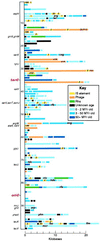Molecular archaeology of the Escherichia coli genome
- PMID: 9689094
- PMCID: PMC21352
- DOI: 10.1073/pnas.95.16.9413
Molecular archaeology of the Escherichia coli genome
Abstract
The availability of the complete sequence of Escherichia coli strain MG1655 provides the first opportunity to assess the overall impact of horizontal genetic transfer on the evolution of bacterial genomes. We found that 755 of 4,288 ORFs (547.8 kb) have been introduced into the E. coli genome in at least 234 lateral transfer events since this species diverged from the Salmonella lineage 100 million years (Myr) ago. The average age of introduced genes was 14.4 Myr, yielding a rate of transfer 16 kb/Myr/lineage since divergence. Although most of the acquired genes subsequently were deleted, the sequences that have persisted ( approximately 18% of the current chromosome) have conferred properties permitting E. coli to explore otherwise unreachable ecological niches.
Figures


References
-
- Lawrence J G. Trends Microbiol. 1997;5:355–359. - PubMed
-
- Hacker J, Blum-Oehler G, Muhldorfer I, Tschape H. Mol Microbiol. 1997;23:1089–1097. - PubMed
-
- McDaniel T K, Kaper J B. Mol Microbiol. 1997;23:399–407. - PubMed
-
- Groisman E A, Ochman H. Trends Microbiol. 1994;2:289–294. - PubMed
-
- Falkow S, Tompkins L S, Silver R P, Guerry P, LeBlanc D J. Ann NY Acad Sci. 1971;182:153–171. - PubMed
Publication types
MeSH terms
LinkOut - more resources
Full Text Sources
Other Literature Sources
Molecular Biology Databases

